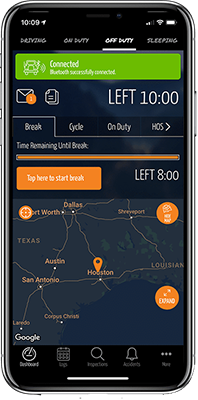
As of January 1st, 2024, California is joining the nationwide Electronic Logging Device (ELD) mandate for intrastate commercial drivers. This means paper logs will become a thing of the past, and ELDs will be the new standard for recording hours of service (HOS).
What does this mean for California transportation? Let's navigate the new ELD landscape in California.
What are ELDs?
ELDs are electronic devices in commercial vehicles. The device monitors the driver's working hours and gathers additional data from the vehicle's engine. This includes driving time, time on duty, and time off duty.
Motor carriers and regulatory agencies receive this information electronically, ensuring accurate and tamper-proof HOS records.
Why are changes occurring in California?
The ELD mandate aims to improve highway safety by reducing driver fatigue and ensuring compliance with HOS regulations. Studies have shown that ELDs can lead to fewer crashes, improved driver health, and more efficient trucking operations.
What do the changes mean for California truckers?
In California, intrastate commercial drivers need to have a working ELD installed by January 1st, 2024. This applies to all drivers who currently use paper logs to record their HOS.
What are the key differences between California and federal ELD regulations?
While California generally aligns with the federal ELD mandate, there are a few key differences:
- 100 Air-Mile Radius: California drivers can drive up to 100 miles from their starting point without needing an ELD. This is known as the "short-haul exemption."
- 12-Hour Limit: California drivers can drive a maximum of 12 hours in a 16-hour on-duty period. This differs from the federal limit of 11 hours.
- 30-Minute Break: California drivers are not required to take a 30-minute break after driving for 8 hours. However, they must ensure they take a 10-hour break at the end of their workday.
 What are the benefits of ELDs for California truckers?
What are the benefits of ELDs for California truckers?
ELDs offer several benefits for drivers, including:
- Reduced paperwork: ELDs automatically record HOS, eliminating the need for manual paperwork and logs.
- Improved accuracy: ELDs provide accurate and tamper-proof HOS records, reducing the risk of compliance violations.
- Greater flexibility: ELDs can help drivers plan their routes more efficiently and comply with HOS regulations.
- Less stress: ELDs reduce stress by preventing driver exhaustion, resulting in safer and less stressful driving.
How should drivers and companies prepare for the California ELD mandate?
Here are some steps you can take to prepare for the California ELD mandate:
- Research ELD options: There are many ELD providers on the market. Choose one that meets your needs and is compatible with your vehicle and software.
- Confirm and test installation: Before January 1st, 2024, it is important to check and set up your ELD properly for accurate installation and best performance.
- Understand your ELD: Most ELD providers offer training on how to use their devices. Take advantage of this training to ensure you are familiar with the features and functions of your ELD.
- Update your HOS records: Switch from paper logs to electronic HOS records before January 1st, 2024.
The California ELD mandate is a significant change for intrastate commercial drivers. To have a smooth transition and get the most out of ELD benefits, understand the new rules and prepare well. To find out how Tenna can help you meet all state and federal requirements, click below.
About Elizabeth Torrez
Elizabeth Torrez is the West Region Territory Manager for Tenna with 18 years of experience in the construction industry, focused primarily on the California market. Elizabeth spent a number of years working for heavy civil construction companies specializing in wet utilities, and four years with United Rentals Trench Safety. She has extensive first-hand experience in assisting contractors with solutions for asset and fleet management. Elizabeth serves on the State Board of Directors for AGC of California, and is a member of UCON, NAWIC Los Angeles, and The Beavers Association.

